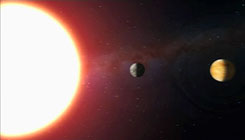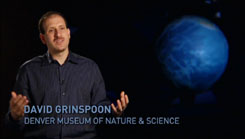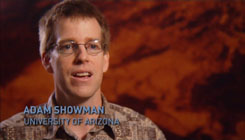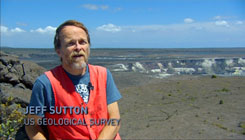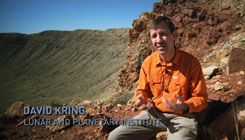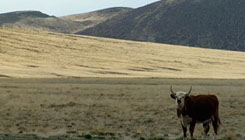This episode covers two planets, both in the innermost
orbits of the solar system, and manages to keep the exploration
of both of them quite interesting and satisfying.
Venus occupies the first half of the episode's screentime.
We start with a short list of the planet's similarities to Earth,
which quickly end after the most fundamental basics like mass, size,
and orbital conditions. A theory is offered for the planet's reverse
direction of spin, while we learn of its shorter year, and its
8-month-long days. The episode doesn't say whether tidal "braking"
from the sun's gravity has influenced this slower spin as well.
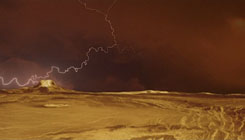
Much is made of the greenhouse effect on Venus's extreme heat,
and the episode proceeds to detail the surface conditions,
geological and volcanic activity, atmospheric composition,
and the nature of the constant lightning on Venus. Yes, this
is a wicked place, as the lively graphics and sound make
abundantly clear.
The second segment is a fairly deep exploration of lava in general...
what makes it common to all inner planets of our solar system,
and what is unique about the composition, texture, and flow properties
of lava on Venus. Also briefly covered are some of Venus's
other features, such as mountains and gorges called "cannali",
as well as the highly reflective properties of its clouds.
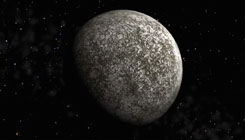
Now half-way though the episode, the third segment switches over to
the planet Mercury. Here we get a quick run-through of its basic properties,
with its year being shorter than its day, causing a wide difference in surface
temperatures from the day-side to the night-side... and apparently
tidal-braking IS in effect here to an extent. Mercury's low mass
is also thought to be a principle factor causing it to become
geologically inert so long ago. Much time is spent looking at the
heavy impact cratering on its surface, including what may be the largest
crater in the solar system.
The fourth segment looks at Meteor Crater in Arizona, and how it is typical
for Mercury in particular and planets throughout the solar system in general.
We also examine the mystery of ice within Mercury's polar craters.
The final segment postulates that volcanic activity must have also played
a minor role on Mercury. Scientists expect "cinder-cone" volcanoes,
such as the ones shown in the Arizona cow pasture, to be much flatter
and wider on Mercury. We also hear about the frustration caused when
1974's Mariner 10 flyby mission only mapped about 45% of the surface of Mercury,
and scientists had to wait decades for the Messenger probe to go back
and finish the job.
Robert G. Strom:
"I want to see the other side.
I don't know what's over there
...and that's been bugging me for over 35 years!"
Chapter Breakdown:
- Introduction
- Earth's Twin Venus
- Exploring the Surface
- The Terrains of Mercury
- Site of Impact
- Volcanic Heritage
|
Participants include:
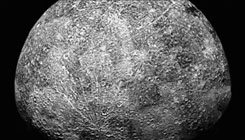
|

